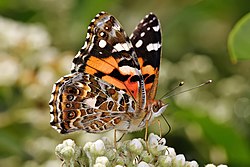Red admiral
| Red admiral | |
|---|---|

| |
| dorsal view | |

| |
| ventral view | |
| Scientific classification | |
| Kingdom: | |
| Phylum: | |
| Class: | |
| Order: | |
| Family: | |
| Genus: | Vanessa
|
| Binomial name | |
| Vanessa atalanta (Linnaeus, 1758)
| |


The red admiral (Vanessa atalanta) is a well-known colourful butterfly, found in temperate Europe, Asia and North America. It has a 45–50 mm (1.8–2.0 in) wing span.[1] The species is resident only in warmer areas, but migrates north in spring, and sometimes again in autumn.
In northern Europe, it is one of the last butterflies to be seen before winter sets in, often feeding on the flowers of ivy on sunny days. The red admiral is also known to hibernate, re-emerging individuals showing prominently darker colourings than first brood subjects. The butterfly also flies on sunny winter days, especially in southern Europe.
In North America, the red admiral generally has two broods from March through October. Most of North America must be recolonized each spring by southern migrants, but this species over-winters in south Texas.
Other red admiral species are:
- The New Zealand red admiral Vanessa gonerilla.
- The Indian red admiral Vanessa indica.
Painted ladies[change | change source]

The painted ladies are a subgenus Cynthis of the red admirals. The topside of their wings is mostly orange in colour.
The group includes:
- The painted lady (Vanessa cardui), which is almost global in its distribution
- Australian painted lady (Vanessa kershawi)
- American painted lady (Vanessa virginiensis)
- West coast lady (Vanessa annabella).
Migration[change | change source]
The painted lady in the UK migrates south in the winter. This has been proved by tracking them on radar. They fly at high altitude on a 9,000-mile migration.[2] It could take up to six successive generations for the species to complete a 9000 mile (14,400 km) round trip from tropical Africa to Europe.[3]
Huge numbers migrate. The radar showed that 11 million painted ladies entered the UK at high altitude in spring 2009. Twenty six million were counted departing in the autumn.
References[change | change source]
- ↑ Shalaway, Scott. 2004. Butterflies in the backyard. Stackpole Books, Mechanicsburg, Pennsylvania. p38 ISBN 0-8117-2695-9.
- ↑ Bardo M. 2012. Radar helps solve painted lady migration mystery. BBC Nature [1] Archived 2012-10-20 at Archive-It
- ↑ Stefanescu, Constantí et al 2012. Multi-generational long-distance migration of insects: studying the painted lady butterfly in the Western Palaearctic. Ecography: pattern and diversity in ecology. [2]

